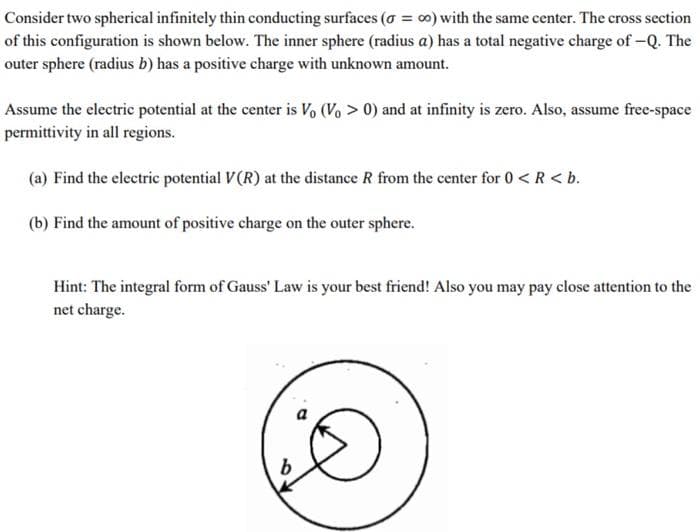Consider two spherical infinitely thin conducting surfaces (= ∞o) with the same center. The cross section of this configuration is shown below. The inner sphere (radius a) has a total negative charge of -Q. The outer sphere (radius b) has a positive charge with unknown amount. Assume the electric potential at the center is Vo (Vo > 0) and at infinity is zero. Also, assume free-space permittivity in all regions. (a) Find the electric potential V(R) at the distance R from the center for 0 < R < b. (b) Find the amount of positive charge on the outer sphere. Hint: The integral form of Gauss' Law is your best friend! Also you may pay close attention to the net charge.
Consider two spherical infinitely thin conducting surfaces (= ∞o) with the same center. The cross section of this configuration is shown below. The inner sphere (radius a) has a total negative charge of -Q. The outer sphere (radius b) has a positive charge with unknown amount. Assume the electric potential at the center is Vo (Vo > 0) and at infinity is zero. Also, assume free-space permittivity in all regions. (a) Find the electric potential V(R) at the distance R from the center for 0 < R < b. (b) Find the amount of positive charge on the outer sphere. Hint: The integral form of Gauss' Law is your best friend! Also you may pay close attention to the net charge.
Related questions
Question

Transcribed Image Text:Consider two spherical infinitely thin conducting surfaces (= ∞o) with the same center. The cross section
of this configuration is shown below. The inner sphere (radius a) has a total negative charge of -Q. The
outer sphere (radius b) has a positive charge with unknown amount.
Assume the electric potential at the center is Vo (Vo > 0) and at infinity is zero. Also, assume free-space
permittivity in all regions.
(a) Find the electric potential V(R) at the distance R from the center for 0 < R < b.
(b) Find the amount of positive charge on the outer sphere.
Hint: The integral form of Gauss' Law is your best friend! Also you may pay close attention to the
net charge.
Expert Solution
This question has been solved!
Explore an expertly crafted, step-by-step solution for a thorough understanding of key concepts.
Step by step
Solved in 2 steps with 2 images
